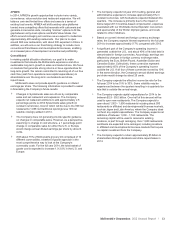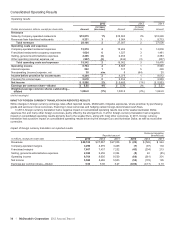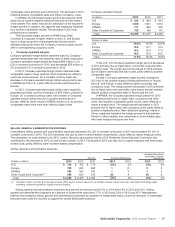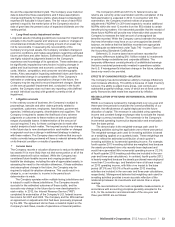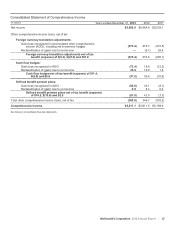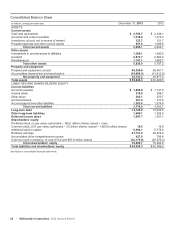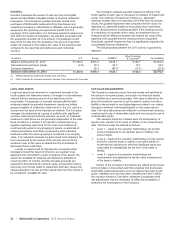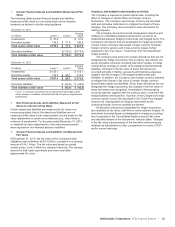McDonalds 2013 Annual Report Download - page 31
Download and view the complete annual report
Please find page 31 of the 2013 McDonalds annual report below. You can navigate through the pages in the report by either clicking on the pages listed below, or by using the keyword search tool below to find specific information within the annual report.
McDonald’s Corporation 2013 Annual Report | 23
life and the expected dividend yield. The Company uses historical
data to determine these assumptions and if these assumptions
change significantly for future grants, share-based compensation
expense will fluctuate in future years. The fair value of each RSU
granted is equal to the market price of the Company’s stock at
date of grant less the present value of expected dividends over the
vesting period.
Long-lived assets impairment review
Long-lived assets (including goodwill) are reviewed for impairment
annually in the fourth quarter and whenever events or changes in
circumstances indicate that the carrying amount of an asset may
not be recoverable. In assessing the recoverability of the
Company’s long-lived assets, the Company considers changes in
economic conditions and makes assumptions regarding estimated
future cash flows and other factors. Estimates of future cash flows
are highly subjective judgments based on the Company’s
experience and knowledge of its operations. These estimates can
be significantly impacted by many factors including changes in
global and local business and economic conditions, operating
costs, inflation, competition, and consumer and demographic
trends. A key assumption impacting estimated future cash flows is
the estimated change in comparable sales. If the Company’s
estimates or underlying assumptions change in the future, the
Company may be required to record impairment charges. Based
on the annual goodwill impairment test, conducted in the fourth
quarter, the Company does not have any reporting units (defined
as each individual country) with goodwill currently at risk of
impairment.
Litigation accruals
In the ordinary course of business, the Company is subject to
proceedings, lawsuits and other claims primarily related to
competitors, customers, employees, franchisees, government
agencies, intellectual property, shareholders and suppliers. The
Company is required to assess the likelihood of any adverse
judgments or outcomes to these matters as well as potential
ranges of probable losses. A determination of the amount of
accrual required, if any, for these contingencies is made after
careful analysis of each matter. The required accrual may change
in the future due to new developments in each matter or changes
in approach such as a change in settlement strategy in dealing
with these matters. The Company does not believe that any such
matter currently being reviewed will have a material adverse effect
on its financial condition or results of operations.
Income taxes
The Company records a valuation allowance to reduce its deferred
tax assets if it is more likely than not that some portion or all of the
deferred assets will not be realized. While the Company has
considered future taxable income and ongoing prudent and
feasible tax strategies, including the sale of appreciated assets, in
assessing the need for the valuation allowance, if these estimates
and assumptions change in the future, the Company may be
required to adjust its valuation allowance. This could result in a
charge to, or an increase in, income in the period such
determination is made.
The Company operates within multiple taxing jurisdictions and
is subject to audit in these jurisdictions. The Company records
accruals for the estimated outcomes of these audits, and the
accruals may change in the future due to new developments in
each matter. In 2012, the Internal Revenue Service ("IRS")
completed its examination of the Company's U.S. federal income
tax returns for 2007 and 2008. The Company and the IRS reached
an agreement on adjustments that had been previously proposed
by the IRS. The agreement did not have a material impact on the
Company's cash flows, results of operations or financial position.
The Company's 2009 and 2010 U.S. federal income tax
returns are currently under examination and the completion of the
field examination is expected in 2014. In connection with this
examination, the Company received notices of proposed
adjustments ("NOPAs") in 2014 and expects to receive additional
NOPAs within the next 12 months from the IRS related to certain
transfer pricing matters. It is reasonably possible that the receipt of
these future NOPAs will provide new information that causes the
Company to reassess the total amount of unrecognized tax
benefits recorded. While the Company cannot estimate the impact
that new information may have on our unrecognized tax benefit
balance, we believe that the liabilities recorded are appropriate
and adequate as determined under Topic 740 - Income Taxes of
the Accounting Standards Codification.
Deferred U.S. income taxes have not been recorded for
temporary differences totaling $16.1 billion related to investments
in certain foreign subsidiaries and corporate affiliates. The
temporary differences consist primarily of undistributed earnings
that are considered permanently invested in operations outside
the U.S. If management's intentions change in the future, deferred
taxes may need to be provided.
EFFECTS OF CHANGING PRICES—INFLATION
The Company has demonstrated an ability to manage inflationary
cost increases effectively. This ability is because of rapid inventory
turnover, the ability to adjust menu prices, cost controls and
substantial property holdings, many of which are at fixed costs and
partly financed by debt made less expensive by inflation.
RECONCILIATION OF RETURNS ON INCREMENTAL INVESTED
CAPITAL
ROIIC is a measure reviewed by management over one-year and
three-year time periods to evaluate the overall profitability of our
markets, the effectiveness of capital deployed and the future
allocation of capital. This measure is calculated using operating
income and constant foreign exchange rates to exclude the impact
of foreign currency translation. The numerator is the Company’s
incremental operating income plus depreciation and amortization
from the base period.
The denominator is the weighted-average cash used for
investing activities during the applicable one-or three-year period.
The weighted-average cash used for investing activities is based
on a weighting applied on a quarterly basis. These weightings are
used to reflect the estimated contribution of each quarter’s
investing activities to incremental operating income. For example,
fourth quarter 2013 investing activities are weighted less because
the assets purchased have only recently been deployed and
would have generated little incremental operating income (12.5%
of fourth quarter 2013 investing activities are included in the one-
year and three-year calculations). In contrast, fourth quarter 2012
is heavily weighted because the assets purchased were deployed
more than 12 months ago, and therefore have a full-year impact
on 2013 operating income, with little or no impact to the base
period (87.5% and 100.0% of fourth quarter 2012 investing
activities are included in the one-year and three-year calculations,
respectively). Management believes that weighting cash used for
investing activities provides a more accurate reflection of the
relationship between its investments and returns than a simple
average.
The reconciliations to the most comparable measurements, in
accordance with accounting principles generally accepted in the
U.S., for the numerator and denominator of the one-year and
three-year ROIIC are as follows:


